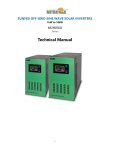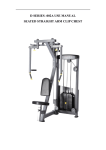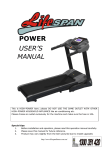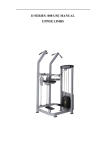Download Chargers Kalhuohfummi User manual
Transcript
Changers Kalhuohfummi User Manual Contents Contents 1. The Changers Kalhuohfummi – an introduction to your solar battery 2. Introduction to energy tracking 3. Content and compatibility 4. Controls and connections 4.1 Controls and connections 4.2 Display elements 5. Four steps to solar sharing 5.1 Generating solar power 5.2 Measuring solar power 5.3 Using your solar power 5.4 Uploading to the community 6. Technical data – the essentials at a glance 7. Care and maintenance 7.1 Safety guidelines 7.2 General guidelines for Lithium-Ion batteries 7.3 Tips for using and handling the Kalhuohfummi system 7.4Cleaning 8. Just in case: Error handling and customer service 8.1 Error handling 8.2 Technical support 9. Disposal – Clean energy, clean recycling! 9.1 Disposal of packaging 9.2 Disposal of the device 02 Introduction the Changers Kalhuohfummi 1.The Changers Kalhuohfummi – an introduction to your solar battery Hello and welcome! You’ve just taken your first step towards becoming a Changer, and are about to start making the world a better place through the power of solar energy. At the heart of what we do is a belief in the ideas of sustainability and responsible living, and our products are an extension of this philosophy. Your Changers Starter Kit has two pieces – the Maroshi panel and Kalhuohfummi battery, designed to be used together but can be used separately, too . The third piece of the puzzle is our community at www.Changers.com. It’s here that you can share your successes with others, compete with friends with your CO2 savings and energy production, and unlock rewards based on your contributions. Being a part of our community unlocks benefits and advantages that go beyond free solar power. In order to get started, you will need the following • • • • • Your Changers Maroshi solar module Your Changers Kalhuohfummi battery An internet connection and an account on www.Changers.com A computer with a USB port and internet access The Changers app, available for Windows XP, Vista or 7, Mac OS 10.5 or higher 03 Introduction to energy tracking | Content and compatibility 2.Introduction to energy tracking The Kalhuohfummi provides portable power for a large range of mobile electronic devices, including smartphones, tablets, portable GPS systems and portable game consoles. The electrical energy that comes through the Maroshi panel is stored in the battery, and can then be used to charge your devices – anyplace, anytime. The Kalhuohfummi is engineered to do considerably more than just store energy. It can accurately tell you how much solar power you are generating, how much you have stored up, and keeps a constant log of both your energy production and CO2 savings. When connected to our community at www.Changers.com, the Kalhuohfummi becomes the portal to our system of awards and rewards. Once you have created an account on our website, simply connect the device via USB, track your savings and start sharing your information. 3.Content and compatibility In order to ensure compatibility with a range of mobile devices, we have supplied a number of adapters in your Changers starter kit. Your package includes: 1x 1x 1x 1x Kalhuohfummi solar battery USB data cable with USB type A connector and micro USB connector USB charging cable with USB type A connector and DC jack Quickstart poster 8xadapter: 1x mini USB 1x Nokia 2mm 1x Sony Ericsson 1xLG 1x Samsung D800 1x Nintendo DS / Game Boy 1x Nintendo DS Lite 1x Sony PSP 04 Controls and connections 4.Controls and connections at a glance Button µ-USB computer output port (data) Status LED A B C D Connection solar module (sun) USB connection cable for charging small electronic devices (power out) Horizontal energy display Inputs and outputs SUN: to connect the solar module (at least 5 V to 30 V, 1 A max.) DATA: to connect to a PC via µ-USB POWER OUT: to connect mobile devices through a USB port (5 V, max. 1 A) 4.1 Controls and connections 05 Controls and connections 4.2 Battery level indicator The current battery level (see Figure 1) is indicated by four LEDs, which are read from left to right. A B C Indicators D Figure 1 The horizontal energy display has three different functions. It shows: 1. The actual battery condition after pressing the button (see table 1). They read from left to right and have the following values: Battery condition Battery capacity A B C D Insufficient energy to charge device Up to 30% Up to 60% Up to 90% Table 1 Key: shines >90 % off 2. The power that supplies the solar module to the Kalhouohfummi. The number of blinks per second shows how many watts of electricity you produce (for example 2 blinks per second means 2 watts power of the solar module). In general, the higher the flash frequency, the more power that is generated by the solar module. Below a power of 1/3 watt LEDs flashes constantly once every three seconds. Depending on the battery capacity the corresponding LEDs will show the charge power (see table 2). Battery condition Battery capacity A B C D Up to 30% Up to 60% Up to 90% > 90 % Battery fully charged Table 2 Key: blinking off 06 Controls and connections 3. The volume level of the battery during charging of electronic equipment. The flashing frequency is once every three seconds and has no dependency on the power taken from the Kalhuohfummi (see table 3). Battery condition Battery capacity A B C D Battery empty Up to 30% Up to 60% Up to 90% Table 3 Key: blinking > 90% Status The status bar indicates the device status, which is described in detail in the respective chapters. Status LED Horizontal energy display Device status Description Status LED Horizontal energy display Standby No charge No discharge Button not pressed – – Show battery condition Press button – See table 1 Charging with solar power Solar module connected – See table 2 Charging from non solar source Power supply connected Red stays on – Charging mobile device Device connected – See table 3 Micro-USB connection to PC Light stays on Stays green – Connected with Changers app / Send data to the community Data transfer to server Blinks green twice a second – Battery deeply discharged Retrieval from deep discharge state Stays green, blinks red every three seconds – Temperature under – 20°C or over + 60°C Red / green alternating twice per second – Input voltage Usolar> 30 V Red / green alternating twice per second – Error messages off 07 Four steps to solar sharing 5.Four steps to solar sharing Ready to get started? Four simple steps make up the Changers system – produce energy, measure energy, consume energy and share energy information. In principle, it is possible to connect any solar module that meets the technical specifications in Chapter 7 to the battery. However, we recommend the use of Changers solar panels. 5.1 Generating solar power • Plug the DC plug of the solar module into the SUN input jack. • Make sure that the solar module is securely mounted by the included suction cups or other tools. Set up your solar panel for optimal solar charging. • As soon as sufficient light falls on the solar module, the horizontal energy display will begin to flash green. Watching the blinking frequency of the status display will let you calibrate the best position for your panel. Faster blinking means more energy, so change the angle of your panel for optimum power. Your Kalhuohfummi constantly measures the power generated by the Maroshi solar module, and stores these values internally. The memory contains the last 1000 values of the solar-energy collector. 5.2 Tracking solar power When these values are uploaded to the Changers.com community, the CO2 savings and the amount of energy produced are displayed graphically for easy reference. This information is then saved, and added to your user profile. With the Kalhuohfummi you can charge a large selection of mobile devices – game consoles, phones, tablets and music players, given they have a USB based charging standard and fit one of the included adapters. Each of the included adapters is suitable for a different device. Before you begin charging, ensure that the device has a suitable charging voltage for a 5 volt supply. Too high electric voltage will cause damage. • Connect the USB charging cable to the POWER OUT port of the Kalhuohfummi. • Connect the device with the USB cable to begin charging. • If in the rare case it is not recognized, please reactivate the output manually by briefly pressing the status button. • The intelligent charging electronics makes it possible to simultaneously charge your Kalhuohfummi and your mobile device. For some devices, such as the apple iPhone and various navigation systems, please use the cable supplied by the manufacturer. Make sure the connectors match the specifications (see Chapter 7, Technical Data). The compatibility may not always be completely guaranteed. 5.3 Using solar power 08 Four steps to solar sharing | Technical information It’s finally time to reap the rewards of your energy production! The software for this process can be found at www.changers.com/en/downloads. After downloading the Changers app, simply follow the installation wizard. Connect the Kalhuohfummi to your computer and start the software. Now you can transfer the data, visualize your savings and upload this information to the community. 5.4 Upload to the community 6.Technical information at a glance Power input • DC-IN: 5 V – 30 V, max. 1 A • MPP-tracking for connection of solar modules • Charge controller optimized for solar power modules, i.e. utilization of short-term lower amounts of energy (e.g. changing cloudiness) Power output • DC OUT: 5 V, max. 1 A • Regulated output voltage i.e., stable voltage for optimum charging of electronic devices • USB type A Energy storage • 2x lithium-ion cell, circular 3.7 V, à 2200 mAh • capacity of about 16 Wh Measurement protocol storage • Capacity for the last 42 days with solar power charging LED indicators • 4 green LEDs on the battery level indicator • 2 red / green LEDs for status indication Connections • USB type A connector for power output (5 V, max. 1 A) • Micro-USB connector for USB data port • DC-socket 2 pin 5.5 x 2.1mm Compatible devices • Device with mini USB input • Device with micro USB input • Nokia 2mm • Sony Ericsson • Samsung D800 • Sony PSP • Nintendo NDS/NGB • Nintendo NDS lite 09 Care and maintenance 7.Care and maintenance – a little goes a long way The Kalhuohfummi is robust, tough and easy to clean. However, like every device with a rechargeable Li-Ion battery, there are several things you can do to ensure efficiency and reliability. Before you contact our customer service team, please ensure you read the notes in Chapter 8 about the care and operation of your device. • Remember, the Kalhuohfummi is a battery. Prolonged exposure to direct sunlight may cause overheating. • Protect the device against vibrations and shock. • Keep it free from dust and moisture and ensure it does not overheat. • Place no flammable, explosive or dangerous objects in the vicinity of the device. • Never attempt to open the device or repair it yourself. • Protect the device from rain, humidity and do not place it in liquids. • Use the device only at a temperature of – 20 °C (– 4 °F) to + 60 °C (140 °F). • If the Charger is not in use, disconnect all cables. Your Kalhuohfummi stores its energy in rechargeable Lithium-Ion batteries. Their capacity is measured in Wh (Watt-hours.) Over time these batteries naturally lose their maximum recharging capacity. Following the guidelines below will ensure a long life of happy, efficient charging for your batteries. • The battery should never be exposed to temperatures above +60 °C (140 °F). The optimal ambient temperature is between 0 °C to + 40 °C (32 °F to 104 °F). • Any prolonged storage of the battery should be done with a battery charge of about 50% (equivalent to two or three LEDs on the display). Failure to do so can result in deep battery self-discharge, which can damage the battery cells. • Note the disposal instructions of batteries! (see Chapter 9, Disposal) 7.1 Safety guidelines 7.2 General guidelines for Lithium-Ion batteries 10 Care and maintenance • Battery protection system. The Kalhuohfummi comes equipped with an electronic system which protects the battery against surfeit load. An intelligently designed circuit means that even if the power is exhausted, the device will not enter a state of deep discharge. This prevents potential damage to the batteries. 7.3 Tips for usage and handling of the Kalhuohfummi system • Solar power battery without charge. If you are unable to load the Kalhuohfummi with solar power and want to prevent a deep discharge, you can simply charge the battery with a conventional charger. For this purpose, you can substitute a Universal Charger with a voltage range from 5 V to 30 V and a current rating of minimum 1 A. • Recharging an almost discharged battery. Connect the device via the USB charging cable to your computer or connect it to your panel in the sun. Allow some time to restore you battery to its original state. Use a soft cloth only when cleaning the case of the device. Do not use harsh chemicals, strong detergents or alcohol based products. 7.4 Cleaning 11 Error handling and customer service 8.Just in case: Error handling and customer service • If the temperature is too high, this will be shown by the status indicator flashing red/green every two seconds. Remove the device from the source of heat and put it somewhere cool until the light stops flashing. • If the temperature of the device is too low this will also be shown by the indicator flashing red/green every two seconds. In this case, move the device to a warm place and wait until the status light stops flashing. • Using an alternative solar module may lead to too high voltage (> 30 V). The status indicator will alternately flash red and green every two seconds. If this occurs, please change the solar panel. • Before contacting our customer service, please check the links between the Kalhuohfummi and Maroshi devices, to ensure that the problem does not lie there. Answers to frequently asked questions can be found on our website www.changers.com. For further questions you can reach us by e-mail: [email protected]. 8.1 Error handling 8.2 Technical support 12 Disposal 9.Disposal – Clean energy, clean recycling We encourage you to recycle your packaging. Packages contain valuable raw materials and should be disposed of sustainably. Old batteries contain substances that do not belong to domestic waste because they could cause damage of health and environment. At the end of their life bring them to a recycling center. This symbol indicates that the product is subject to the European Directive 2002/96/EC subject. This product should be disposed separately from normal household waste. For expert information on the disposal of your device, contact your local recycling center. Compliance statement: This device complies with part 15 of the FCC Rules. Operation is subject to the following two conditions: (1) This device may not cause harmful interference, and (2) this device must accept any interference received, including interference that may cause undesired operation. Modifications not expressly approved by this company could void the user‘s authority to operate the equipment. 9.1 Disposal of packaging 9.2 Disposal of the device 13




















